CHEVROLET EXPRESS 1998 1.G Owners Manual
Manufacturer: CHEVROLET, Model Year: 1998, Model line: EXPRESS, Model: CHEVROLET EXPRESS 1998 1.GPages: 386, PDF Size: 20.74 MB
Page 231 of 386
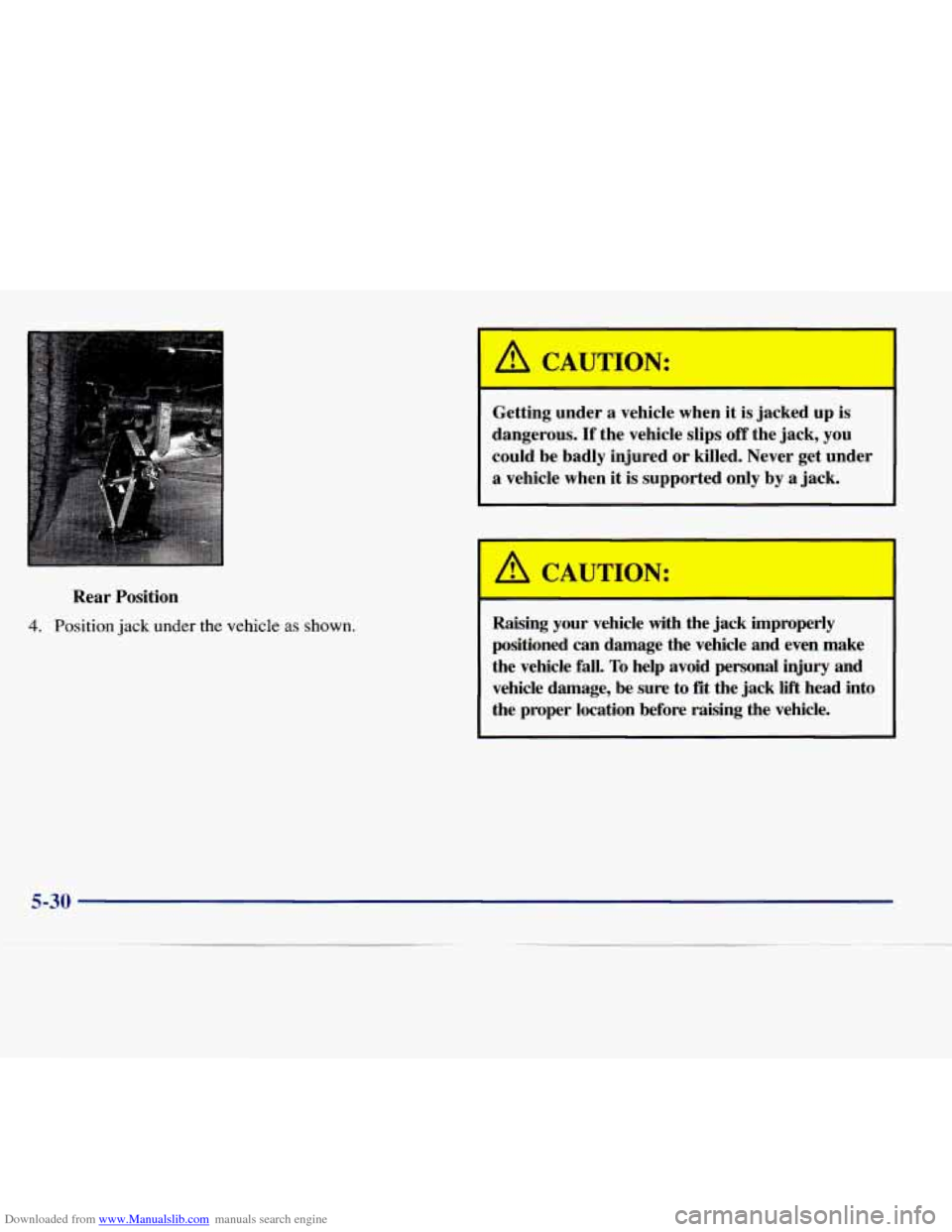
Downloaded from www.Manualslib.com manuals search engine Rear Position
4. Position jack under the vehicle as shown.
CAUTION:
Getting under a vehicle when it is jacked up is
dangerous.
If the vehicle slips off the jack, you
could be badly injured or killed. Never get under
a vehicle when it is supported only by a jack.
A CAUTION:
--- -
Raising your vehicle with the jack improperly
positioned can damage the vehicle and even make
the vehicle fall.
To help avoid personal injury and
vehicle damage, be
sure to fit the jack lift head into
the proper location before raising the vehicle.
5-30
Page 232 of 386
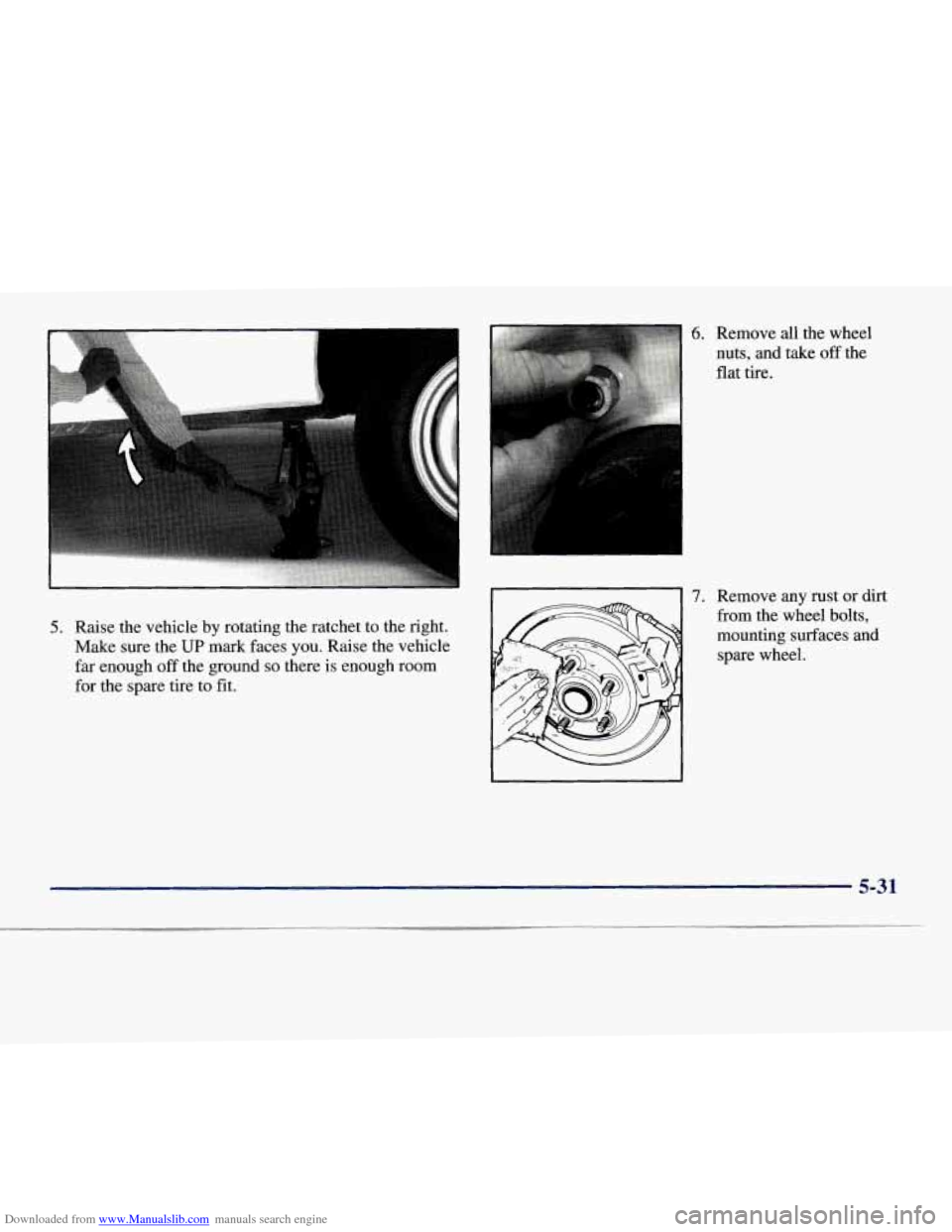
Downloaded from www.Manualslib.com manuals search engine 5. Raise the vehicle by rotating the ratchet to the right.
Make sure the
UP mark faces you. Raise the vehicle
far enough
off the ground so there is enough room
for the spare tire
to fit.
6. Remove all the wheel
nuts, and take off the
flat tire.
7. Remove any rust or dirt
from the wheel bolts,
mounting surfaces and
spare wheel.
5-31
Page 233 of 386
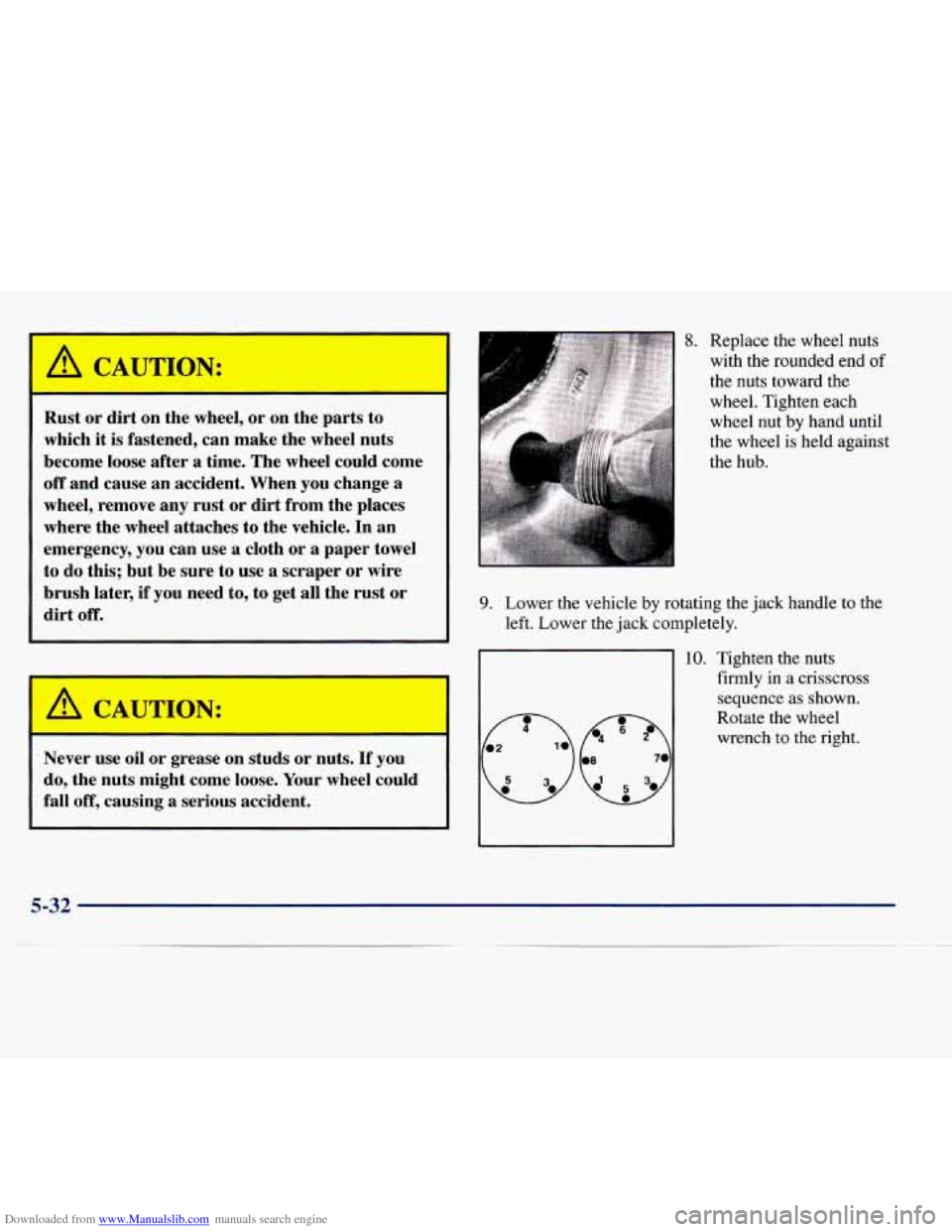
Downloaded from www.Manualslib.com manuals search engine I A CAUTION:
Rust or dirt on the wheel, or on the parts to
which it is fastened, can make the wheel nuts
become loose after a time. The wheel could come
off and cause an accident. When you change a
wheel, remove any rust or dirt from the places
where the wheel attaches to the vehicle. In an
emergency, you can use
a cloth or a paper towel
to do this; but be sure to use a scraper or wire
brush later, if you need to, to get all the rust or
dirt
off.
I A CAUTION: I
Never use oil or grease on studs or nuts. If you
do, the nuts might come loose. Your wheel could
fall
off, causing a serious accident.
8. Replace the wheel nuts
with the rounded end
of
the nuts toward the
wheel. Tighten each
wheel nut
by hand until
the wheel is held against
the hub.
9. Lower the vehicle by rotating the jack handle to the
left. Lower the jack completely.
1
10. Tighten the nuts
firmly in
a crisscross
sequence as shown.
Rotate the wheel
wrench to the right.
5-32
Page 234 of 386
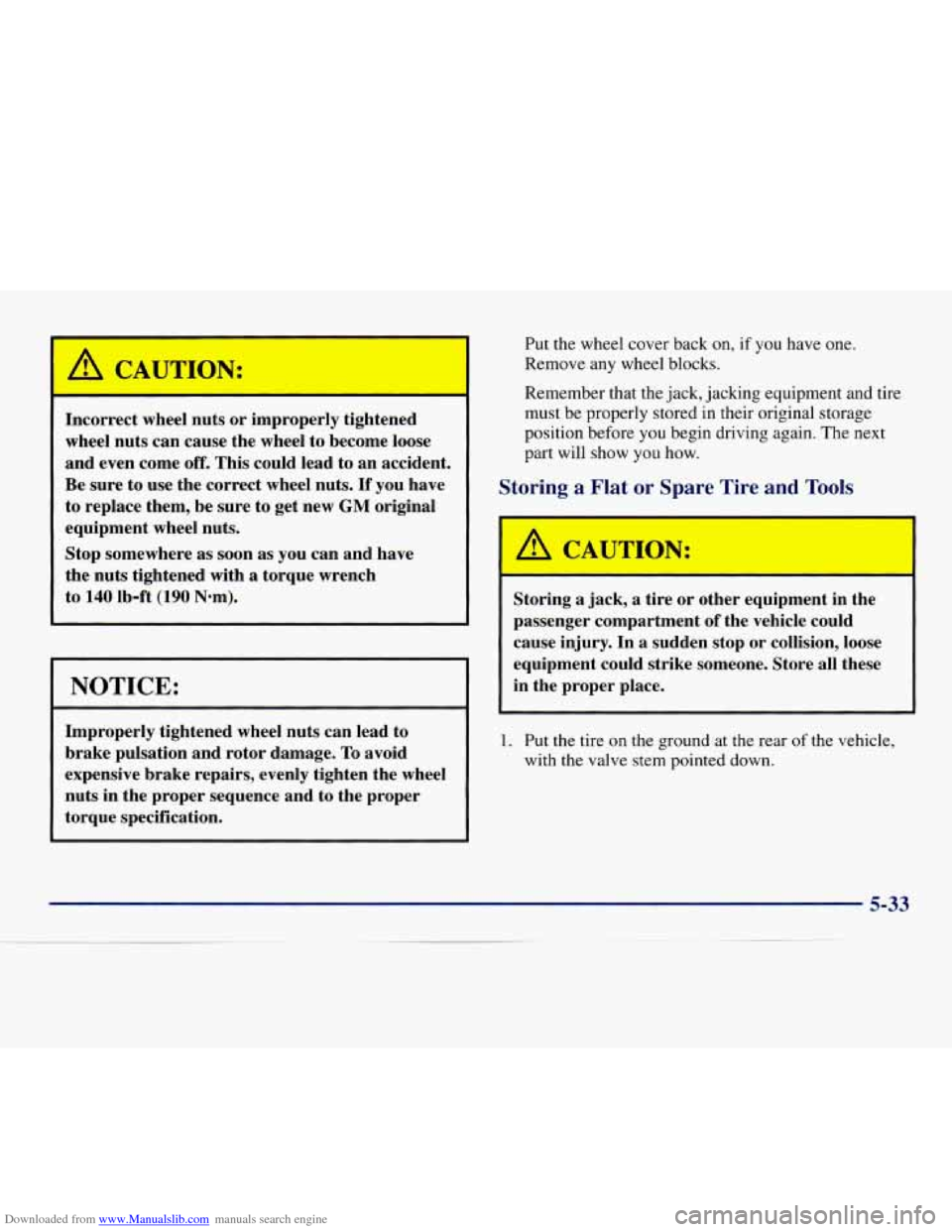
Downloaded from www.Manualslib.com manuals search engine /1 CAUTION:
Incorrect wheel nuts or improperly tightened
wheel nuts can cause the wheel to become loose
and even come
off. This could lead to an accident.
Be sure to use the correct wheel nuts.
If you have
to replace them, be sure to get new
GM original
equipment wheel nuts.
Stop somewhere as soon as you can and have
the nuts tightened with a torque wrench
to
140 lb-ft (190 Nmm).
NOTICE:
Improperly tightened wheel nuts can lead to
brake pulsation and rotor damage. To avoid
expensive brake repairs, evenly tighten the wheel
nuts in the proper sequence and to the proper
torque specification. Put the wheel
cover back on, if
you have one.
Remove any wheel blocks.
Remember that the jack, jacking equipment and tire
must be properly stored
in their original storage
position before
you begin driving again. The next
part will show
you how.
Storing a Flat or Spare Tire and Tools
A CAUTION:
Storing a jack, a tire or other equipment in the
passenger compartment of the vehicle could
cause injury. In a sudden stop or collision, loose
equipment could strike someone. Store all these
in the proper place.
1. Put the tire on the ground at the rear of the vehicle,
with the valve stem pointed down.
5-33
Page 235 of 386
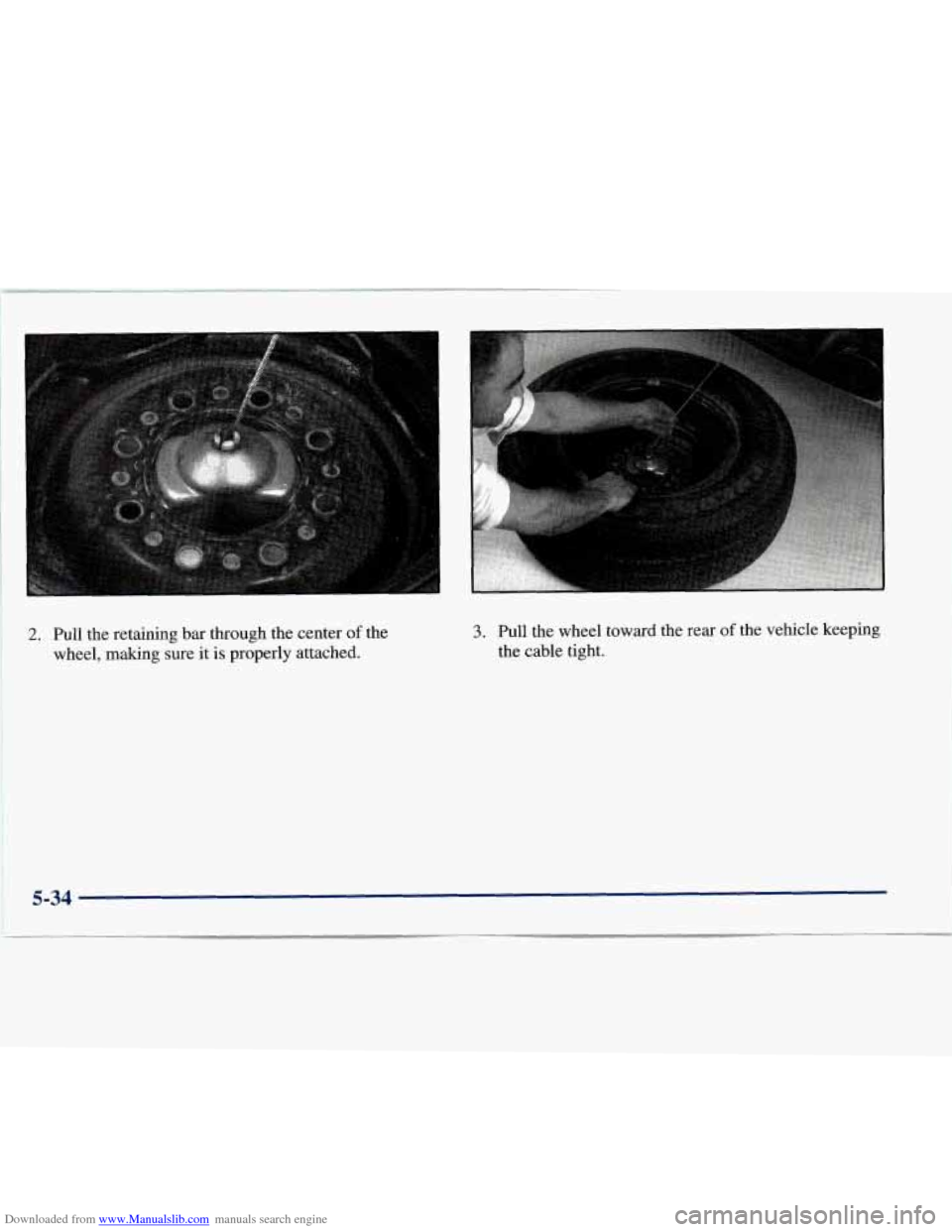
Downloaded from www.Manualslib.com manuals search engine 2. Pull the retaining bar through the center of the
wheel, making sure it is properly attached. 3. Pull the wheel toward the rear of the vehicle keeping
the cable tight.
5-34
Page 236 of 386
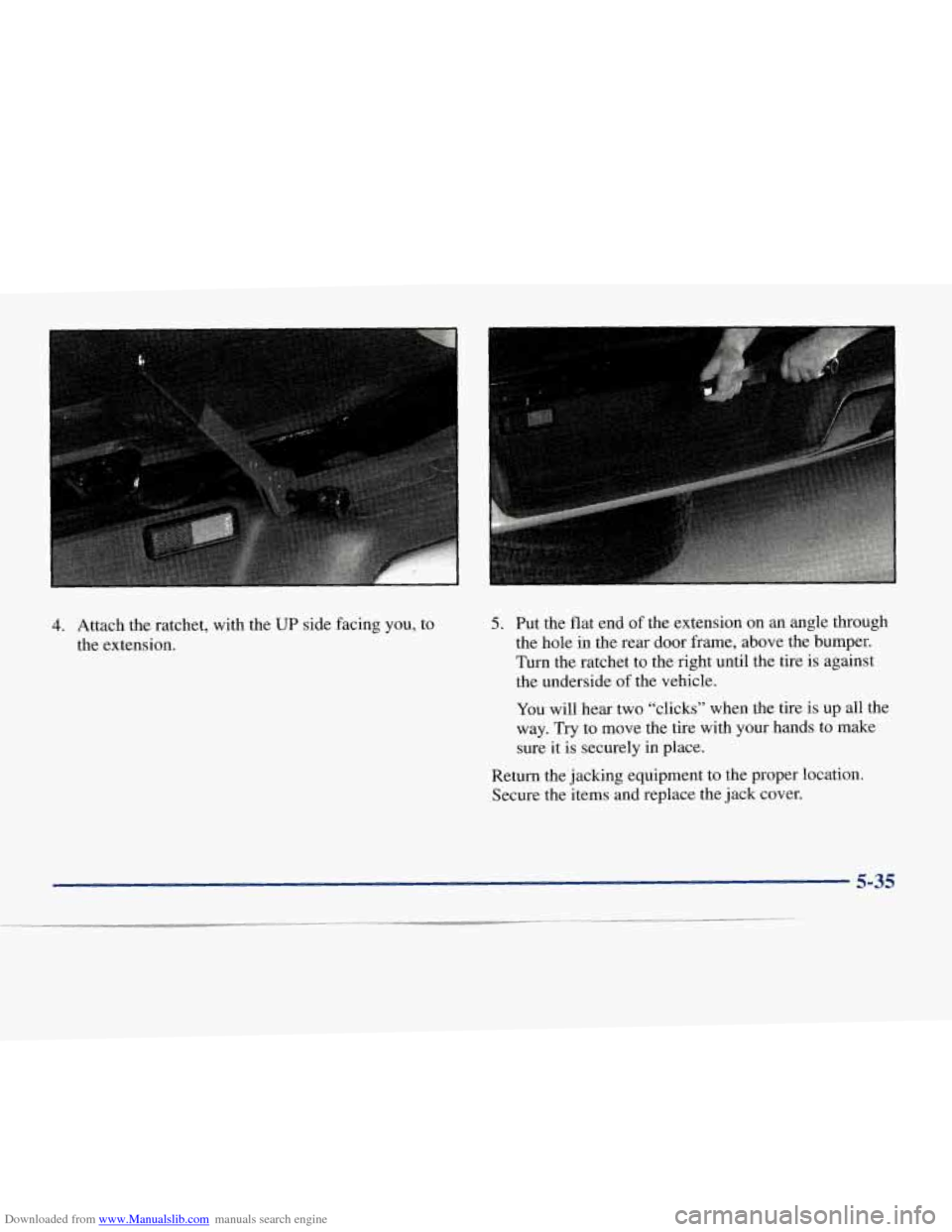
Downloaded from www.Manualslib.com manuals search engine 4. Attach the ratchet, with the UP side facing you, to
the extension. 5. Put the flat end of the extension on an angle through
the hole in the rear door frame, above the bumper.
Turn the ratchet to the right until the
tire is against
the underside
of the vehicle.
You will hear two “clicks” when the tire
is up all the
way. Try to move the tire with your hands to make
sure it is securely in place.
Return the jacking equipment to the proper location.
Secure the items and replace the jack cover.
5-35
Page 237 of 386
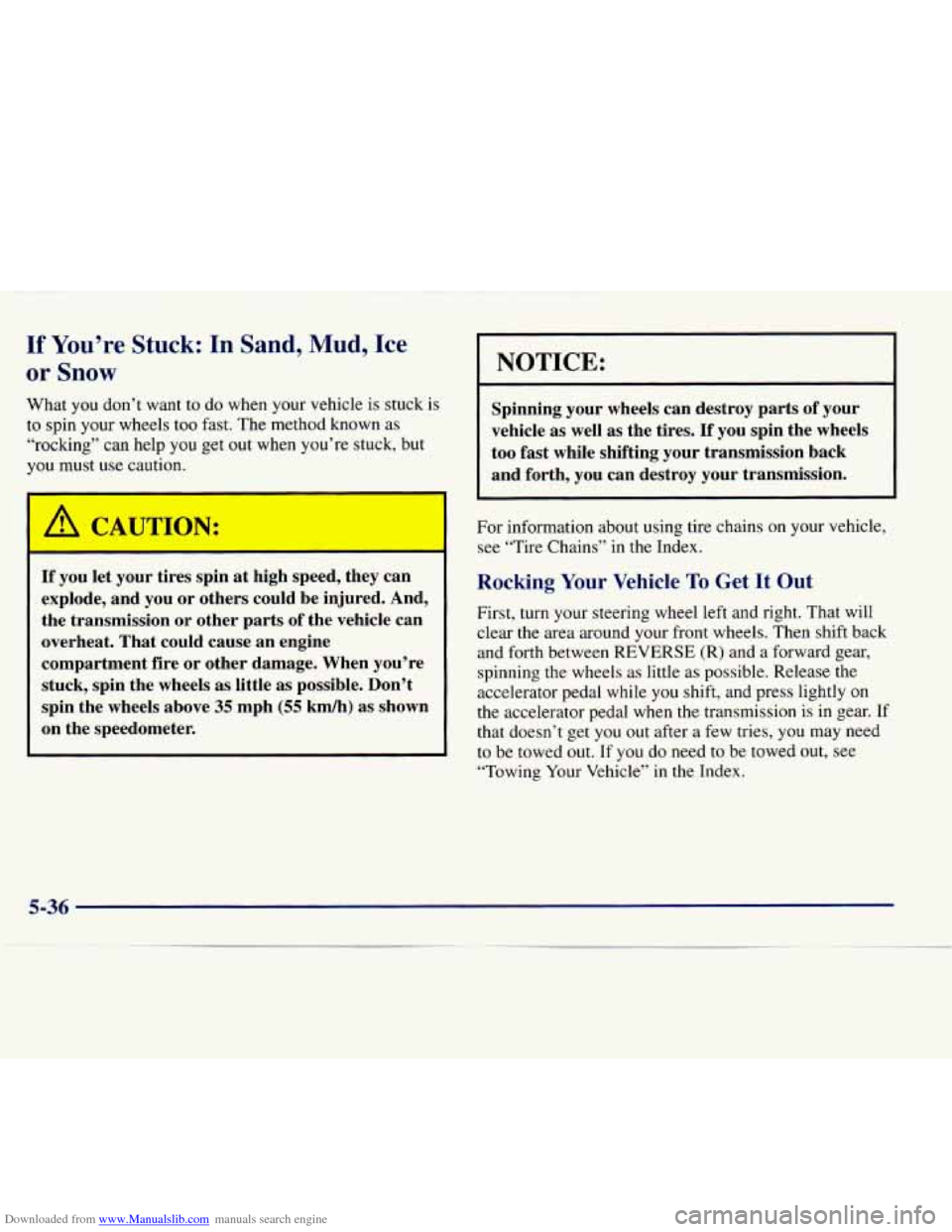
Downloaded from www.Manualslib.com manuals search engine If You’re Stuck: In Sand, Mud, Ice
or Snow
What you don’t want to do when your vehicle is stuck is
to spin your wheels too fast. The method known as
“rocking” can help you get
out when you’re stuck, but
you must
use caution.
1 A CAUTION:
1
If you let your tires spin at high speed, they can
explode, and you or others could be injured. And,
the transmission or other parts of the vehicle can
overheat. That could cause an engine
compartment fire or other damage. When you’re
stuck, spin the wheels as little
as possible. Don’t
spin the wheels above
35 mph (55 km/h) as shown
on the speedometer.
I NOTICE:
Spinning your wheels can destroy parts of your
vehicle as well as the tires.
If you spin the wheels
too fast while shifting your transmission back
and forth, you can destroy your transmission.
For information about using tire chains
on your vehicle,
see “Tire Chains” in the Index.
Rocking Your Vehi :o Get It Out
First, turn your steering wheel left and right. That will
clear the area around your front wheels. Then shift back
and forth between REVERSE
(R) and a forward gear,
spinning the wheels
as little as possible. Release the
accelerator pedal while
you shift, and press lightly on
the accelerator pedal when the transmission is in gear. If
that doesn’t get
you out after a few tries, you may need
to be towed
out. If you do need to be towed out, see
“Towing Your Vehicle” in the Index.
5-36
Page 238 of 386
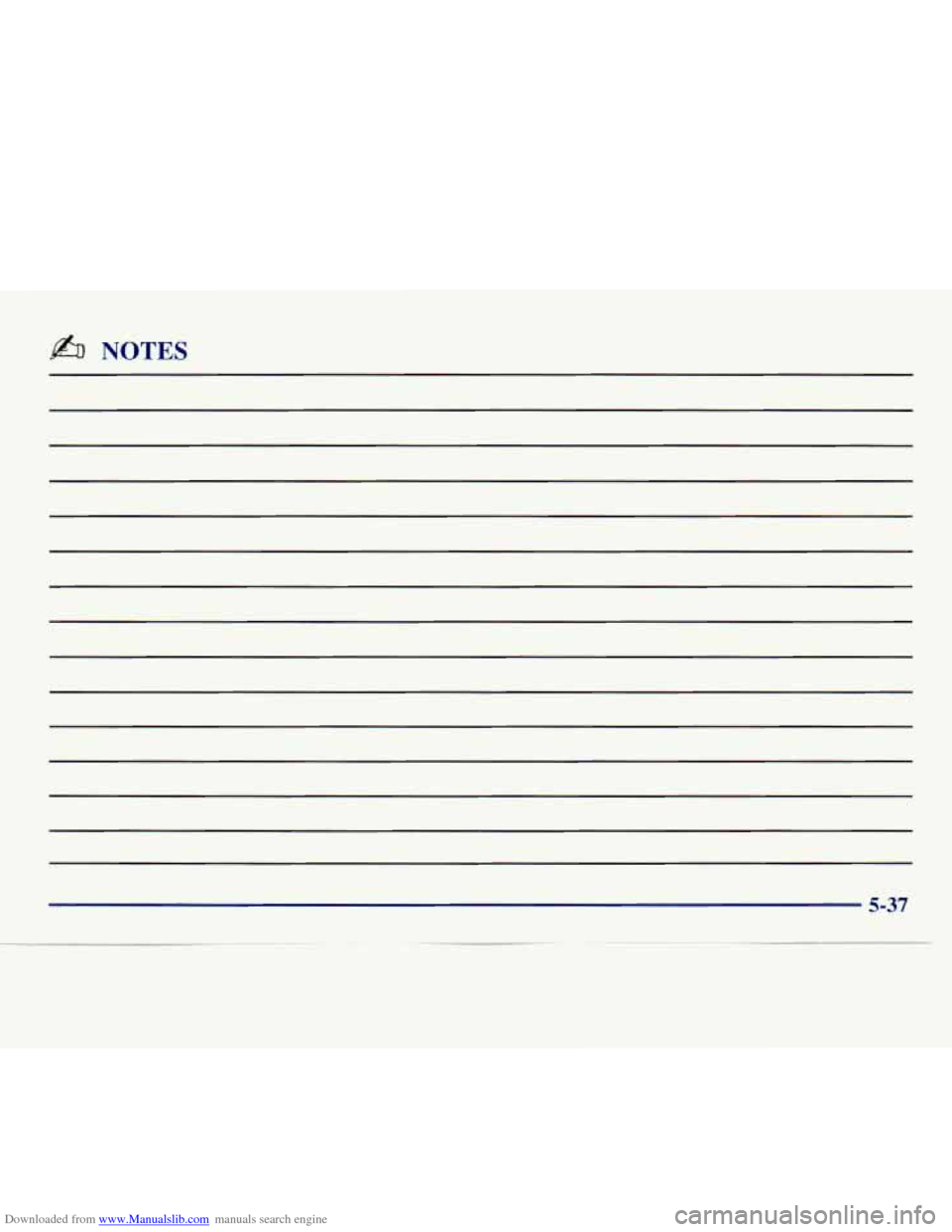
Downloaded from www.Manualslib.com manuals search engine b%J NOTES
Page 239 of 386
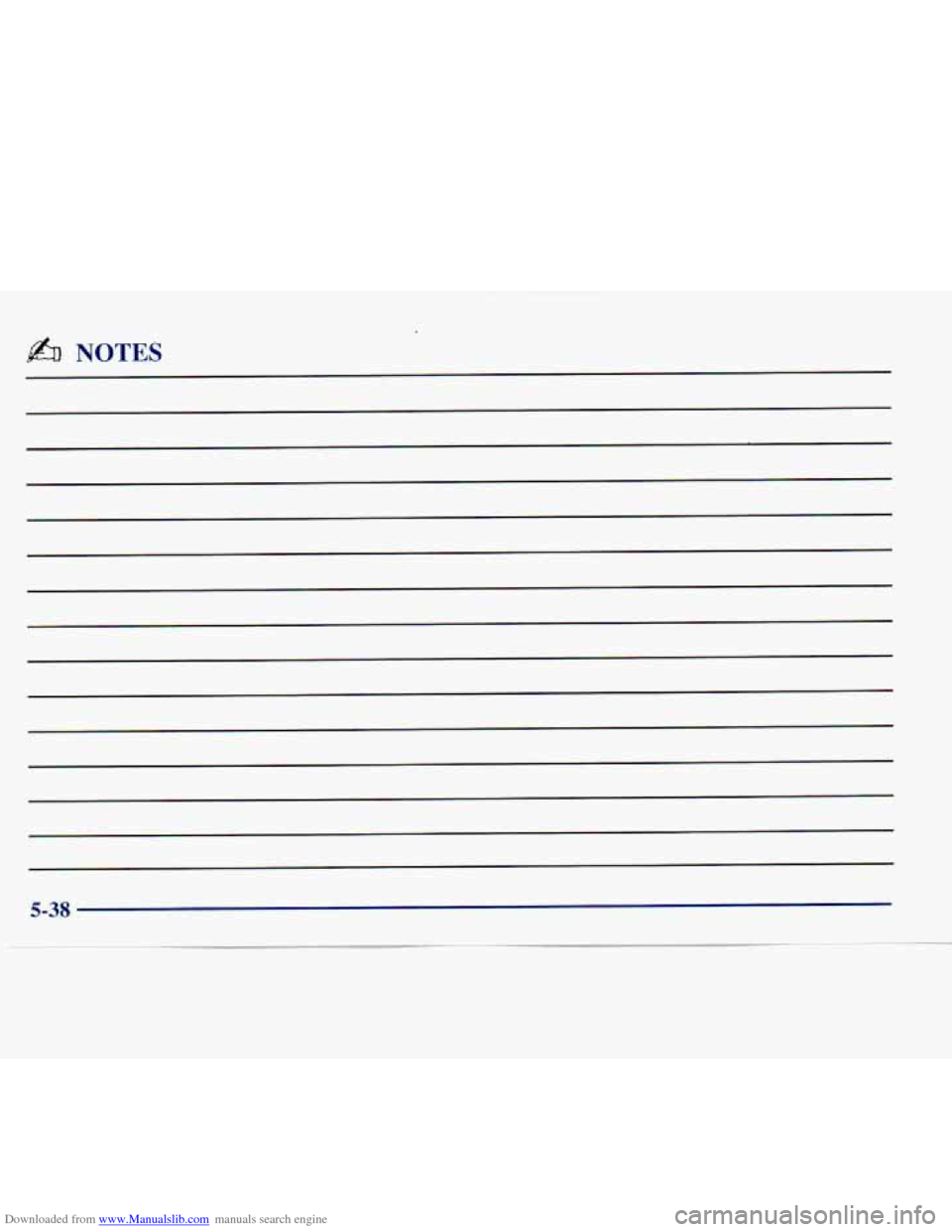
Downloaded from www.Manualslib.com manuals search engine b NOTES
Page 240 of 386
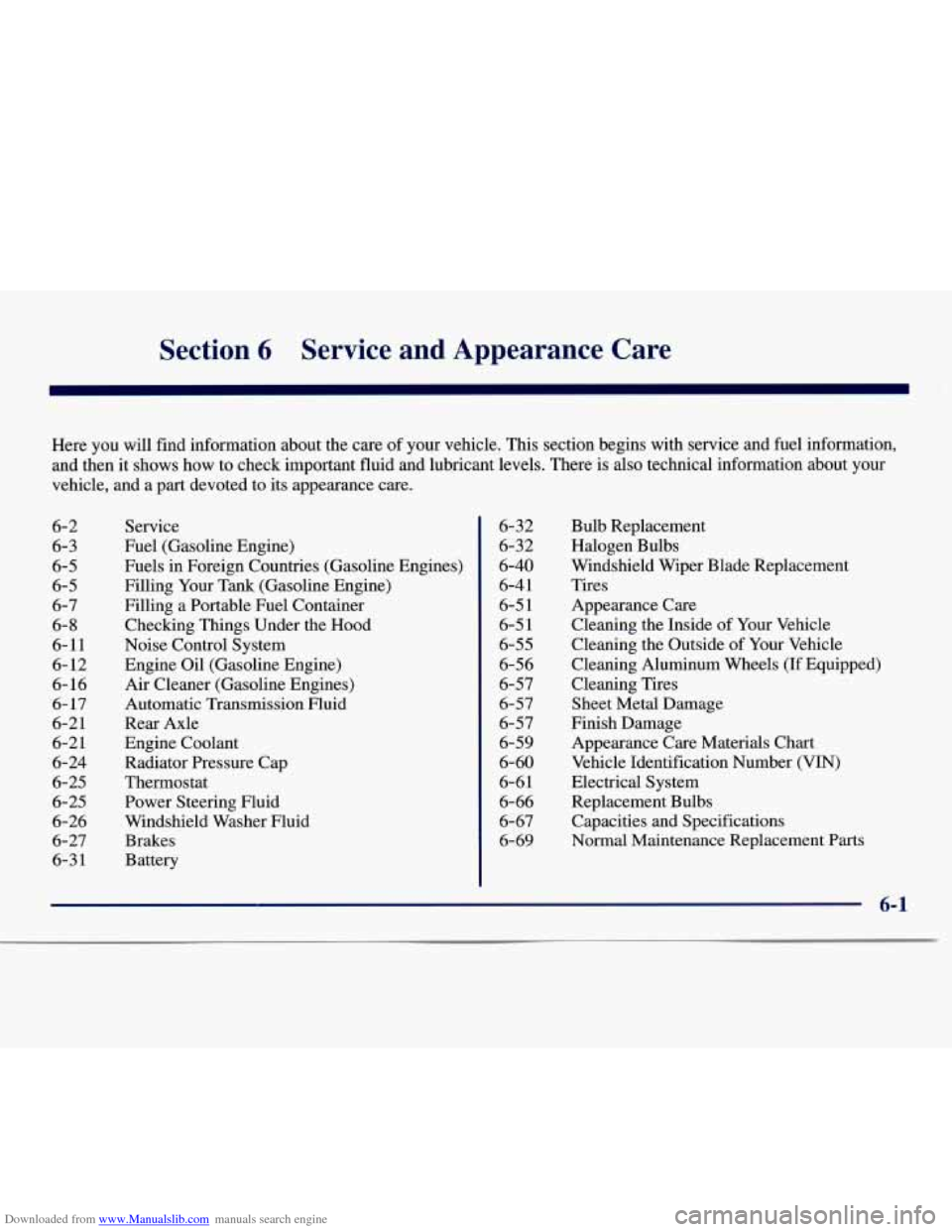
Downloaded from www.Manualslib.com manuals search engine Section 6 Service and Appearance Care
Here you will find information about the care of your vehicle. This section begins with service and fuel information,
and then it shows how to check important fluid and lubricant levels. There is also technical information about your
vehicle, and a part devoted to its appearance care.
6- 2
6-3
6-5
6-5
6-7
6-
8
6-11
6- 12
6-
16
6- 17
6-2 1
6-2 1
6-24
6-25
6-25
6-26
6-27
6-3
1
Service
Fuel (Gasoline Engine)
Fuels in Foreign Countries (Gasoline Engines)
Filling Your Tank (Gasoline Engine)
Filling a Portable Fuel Container
Checking Things Under the
Hood
Noise Control System
Engine Oil (Gasoline Engine)
Air Cleaner (Gasoline Engines)
Automatic Transmission Fluid
Rear Axle
Engine Coolant
Radiator Pressure Cap
Thermostat
Power Steering Fluid
Windshield Washer Fluid
Brakes Battery 6-32
6-32
6-40
6-4
1
6-5 1
6-5 1 6-55
6-56
6-57
6-57
6-57
6-59
6-60
6-6
1
6-66
6-67
6- 69 Bulb Replacement
Halogen Bulbs
Windshield Wiper Blade Replacement
Tires Appearance Care
Cleaning the Inside of Your Vehicle
Cleaning the Outside
of Your Vehicle
Cleaning Aluminum Wheels (If Equipped)
Cleaning Tires
Sheet Metal Damage
Finish Damage Appearance Care Materials Chart
Vehicle Identification Number (VIN)
Electrical System
Replacement Bulbs Capacities and Specifications
Normal Maintenance Replacement Parts